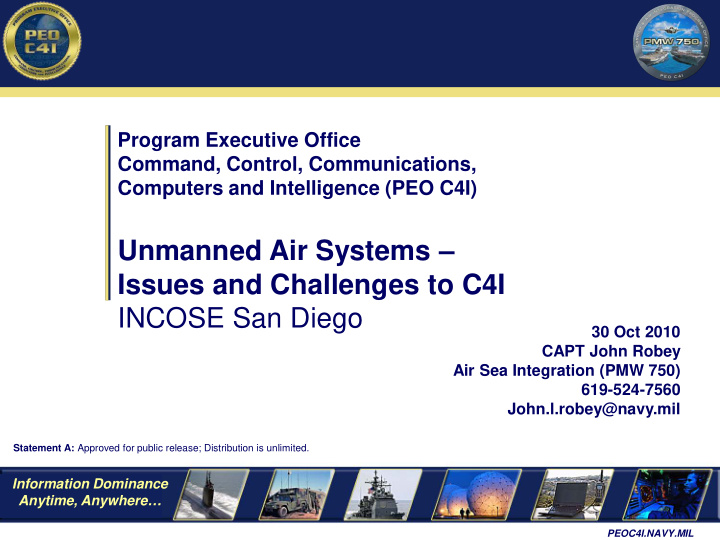



Program Executive Office Command, Control, Communications, Computers and Intelligence (PEO C4I) Unmanned Air Systems – Issues and Challenges to C4I INCOSE San Diego 30 Oct 2010 CAPT John Robey Air Sea Integration (PMW 750) 619-524-7560 John.l.robey@navy.mil Statement A: Approved for public release; Distribution is unlimited. Information Dominance Anytime, Anywhere… PEOC4I.NAVY.MIL
CNO's Unifying Vision and Guiding Principles Vision - "Pioneer, field and employ game-changing capabilities to ensure Information Dominance over adversaries and Decision Superiority for commanders, operational forces and the nation" • First Principles Include: Emphasize UAS/RPV and autonomous Every platform is a sensor platforms Every sensor is networked UAS's increasingly sea-based Build a little; test a lot One operator controls multiple platforms Spiral development/acquisition Data discoverable and accessible Plug-n-play sensor payloads Missions drive requirements Reduce afloat/airborne manning Commonality in interfaces, data links Transition to remoted, automated and control stations Every shooter capable of using target Collectors dynamically tasked data derived from any sensor Statement A: Approved for public release; Distribution is unlimited. 2
UAS Family of Systems 3 DISTRIBUTION STATEMENT A: Approved for public release; Distribution is unlimited. #09-983
BAMS UAS OV-1 Narrowband Global Wideband SATCOM Positioning SATCOM System UA Maritime Forces MOB Joint Navy HQ(MOC)/ MCS Allied/Coalition Battle FOB Management Nodes EO/IR MCS Maritime Forces Teleport Radar, ESM & AIS Airspace Control Authority BAMS Payload Data Airspace Communications Joint Allied/ BAMS Air Vehicle C2 Airborne Communications Relay Coalition Defense Info System Network/Global Info Grid BAMS UAS Nodes (UA, MOB/FOB MCS) Exploitation Sites 4 DISTRIBUTION STATEMENT A: Approved for public release; Distribution is unlimited. #09-983
Managing the Processing, Exploitation and Dissemination (PED) of Data Sensor data from UA Teleport Sensor data from UA BAMS UA Wideband SATCOM Worldwide CDL / Link-16 Main Operating Base (MOB) MPRA DCGS-N Afloat Mission CSG/ESG DISA Nodes Control First Pass GIG POP System Analysis from (MCS) MCS GCCS-M, AIS, Chat, VoIP DCGS-N Enterprise SIPRNET Node Exploitation Sites Sensor data to Exploitation Sites (e.g. NMIC, MOC/MIOCs, NGA, DCGS FoS, FIOC) DCGS Family of Systems (Air Force, Army, Marines, SOF, DCGS-IC) 5 DISTRIBUTION STATEMENT A: Approved for public release; Distribution is unlimited. #09-1061
Exponential Data Growth: Enabler & Challenge! (From MIEA Study) 10 24 10 21 Max of 50 Mbps Theater Data Stream (2006): per channel ~270 TB of NTM data / year Current single mode fiber 10 18 carries 960 Gpbs Capability Gap 10 15 UUVs FIRESCOUT VTUAV DATA 10 12 GIG Data Capacity (Services, Transport & Storage) 2000 2005 2010 2015 & Beyond Statement A: Approved for public release; Distribution is unlimited. 6 MIEA Review
Navy Data Strategy Challenge (from PEO C4I ISR Data Study - MITRE) Data Transmission Collection Data Decisions Decisions -Should we collect? -Send all of it? -Which sensors? -Compress it? -Stream it? -When/where to collect? -Just send a metadata -Where to process? -When to transmit ? synopsis? -Where to store? -Adjust Quality of Service? Enterprise/Cloud Data Decisions -Data center consolidation? -Degree of distributed processing? Systems Data Decisions -“Big Data” storage and - Analyze it? processing standards? -“Mark it up” (i.e., metadata)? -Time to live? -Store it? Where and for how long? Searchable? -Data format Tactical Data Decisions -Distribute it? How and which systems need it? standardization? -Analyze it? Is Expertise available? -Which system becomes “authoritative?” -Store it? How long? Capacity? -How to aggregate different results? -Transmit it? How? Capacity? -How to track provenance? Who has -Throw it out? touched it? -How to “mark it up?” -Throw it out? Why collect it and send it to begin with? Each decision is an opportunity to improve the end-to-end mission capability and streamline the OODA* Loop *Observe, Orient, Decide, Act (OODA) Statement A: Approved for public release; Distribution is unlimited. 7
Summary • Proliferation of UASs (and their data) pose a significant challenge to Navy C4I architectures and TTPs • Data Strategies and ISR CONOPS are immature • Acquisition requirements and ownership of data processing, exploitation and dissemination (PED) are unclear – Getting the right data to the right customer at the right time – Manpower - who does what and where – Bandwidth – how much is enough, what needs to be sent and to whom – Automation / Data Fusion – turning data into information • Disciplined Systems Engineering and requirements derivation across SYSCOMs and acquisition programs is critical Statement A: Approved for public release; Distribution is unlimited. 8
Recommend
More recommend